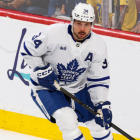The concussion lawsuit involving more than 100 former NHL players and the league reached a tentative agreement on Monday, meaning the NHL will pay out millions of dollars as the result of head injuries and their lingering effects on players. The case, which was consolidated in federal court in Minnesota, had been in mediation for months before an agreement was reached.
The language involved in court proceedings and lawsuit documents can often be tough to comprehend, so here's a simple breakdown and explainer for anyone looking to digest the case and its resolution.
What is the lawsuit?
More than 100 ex-NHL players (318 plaintiffs in total) came together to file a joint lawsuit against the league for failing to protect and better prevent head trauma in players. They also accused the NHL of failure to warn and educate players of the risks that come with a career in professional hockey, while simultaneously promoting violent aspects of the sport that can lead to brain trauma.
A number of players involved in the suit claim that they suffer from neurodegenerative conditions -- including headaches, irritability, sensitivity to light, mood and personality swings, sleeping issues, and depression -- as a result of concussions suffered during their playing days.
The NFL had a similar class-action lawsuit that dragged on for years before finally coming to a settlement that totaled over a billion dollars.
How has the league responded?
The NHL has repeatedly tried to dismiss the claims, and commissioner Gary Bettman is on record as saying that the lawsuit is "without merit."
While discussing the purported link between concussions and CTE/brain trauma, Bettman said this in 2015: ''From a medical and scientific standpoint, there is no evidence yet that one leads to the other.'' This statement came on the heels of the discovery that NHL defenseman Steve Montador suffered from CTE before his death at age 35.
Is this a class-action suit?
No. This July, a judge denied the bid for class-action status, closing the door to more than 5,000 former players who would have been allowed to join the case. Class-action status would have allowed for a plaintiff group involving all living former NHL players, plus another group of all retired players diagnosed with a neurological disease.
What are the terms of the settlement?
While the agreement is still tentative, documents released by the NHL indicate that the league will pay out between $17-$19 million dollars in the settlement. A little under $7 million will be divided between the 318 plaintiffs (averaging out to $22,000 per plaintiff) while over $7 million will go to lawyers (attorney fees were waived as part of the deal) and administrative costs, collectively.
The settlement also states that the NHL will pay for medical testing and treatment (up to $75,000) for the individuals involved in the case. The league will also establish a "Common Good Fund" as an emergency outlet for ex-players in need. The league will give $2.5 million to that fund over the course of five years.
Does this mean the league is accepting responsibility for the players' injuries?
No. In a brief statement announcing the deal on Monday, the league is very clear about not taking the blame.
"The NHL does not acknowledge any liability for the Plaintiffs' claims in these cases," the statement read. "However, the parties agree that the settlement is a fair and reasonable resolution and that it is in the parties' respective best interests to receive the benefits of the settlement and to avoid the burden, risk and expense of further litigation."
Basically: "It's not our fault but we'll pay you to shut up and leave us alone."
Now what?
Players involved in the suit can either choose to accept the terms of settlement, or they can decline the settlement to pursue personal injury claims against the league themselves. Players not involved in the case can also choose to file suit against the league.






















